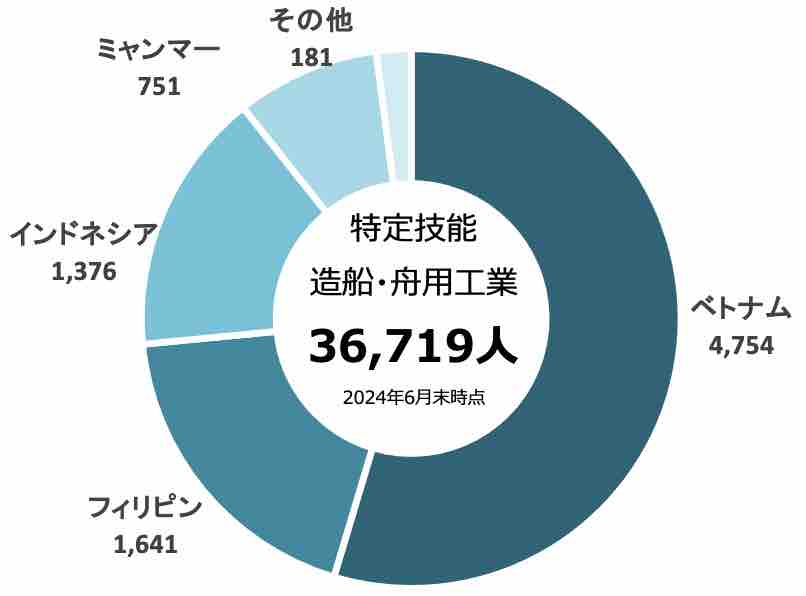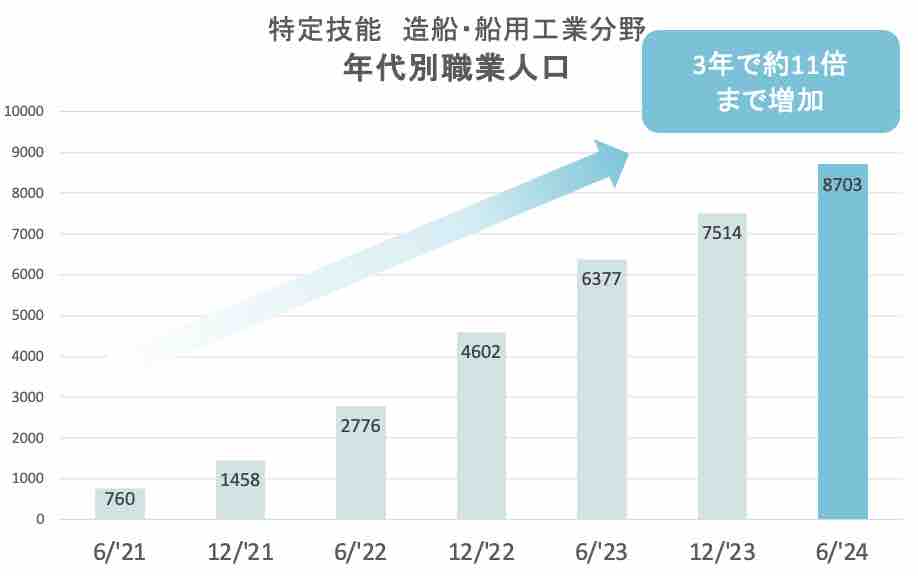Job Introduction - About the Shipbuilding and Marine Industry
This page provides information on the job categories where you can work with a shipbuilding and marine industry qualification, the average salary for each job, the current number of workers, and job descriptions, offering useful information for career choices.
Index
- 1. What is the Specified Skilled Worker (SSW) in Shipbuilding and Marine Industry?
- 2. Job details
- 3. Required Exams and Qualifications
1. What is SSW in the Accommodation Industry?
1-1 Background
In the shipbuilding and marine industry, securing personnel has become difficult due to the declining birthrate, young people's decreasing interest in automobiles, and the diversification of career choices, leading to a severe labor shortage. The average age of workers in the shipbuilding and marine industry is rising, and it has become challenging to secure sufficient personnel solely from domestic sources. To address this situation, a system was introduced with the aim of accepting foreign workers.
1-2 Population and Current Status
The Immigration Services Agency aggregates and publishes the number of people working under the SSW qualification every six months (previously every three months until 2022). According to the data, the population ratio by country or age is as follows.

As of the end of June 2024, 2,585 people are working in the shipbuilding and marine industry under the Specified Skilled Worker program. Most of the workers come from the Asian region, with Vietnam, the Philippines, Indonesia, and Myanmar ranking in that order.

The Specified Skilled Worker system started in 2019, and the number of people working in the shipbuilding and marine industry under this program has increased by about 2.5 times over the past three years. It is expected that the number of accepted workers will continue to grow in the future.
source : 出入国在留管理庁(https://www.moj.go.jp/isa/applications/ssw/zairyuarchive.html)
There are two systems for accepting foreign workers: the Technical Intern Training Program and the SSW Program, but their purposes and characteristics are quite different.
The Technical Intern Training Program aims to equip young people from developing countries with Japanese technical skills, enabling them to contribute to their home countries' development after returning. The main purpose is skill acquisition, and it is positioned as training rather than labor. Therefore, job changes are not allowed, and the maximum duration is five years.
On the other hand, the SSW Program was established to supplement Japan's labor shortage. There are two types, SSW 1 and SSW 2, which accept foreign workers as immediate assets. Job changes are allowed, and in SSW 2, it is possible to bring family members and even apply for permanent residency. A test to prove skills and Japanese language ability is required, and workers with practical experience are preferred.
In addition, foreign workers who have completed the Technical Intern Training Program can transition to the SSW Program. Experience gained through technical training is recognized, and part of the SSW 1 test is exempted, making the transition relatively smooth. This allows foreign workers to continue working in Japan for a longer period after completing their internships, with opportunities for job changes and career advancement.
2. About Jobs and Duties in the Accommodation Industry
2-1 2-1 Job Description
The Specified Skilled Worker in "Shipbuilding and Marine Industry" can work in one of three areas: Shipbuilding, Ship Machinery, or Ship Electrical and Electronic Equipment.
Shipbuilding
- Shipbuilding
Welding / Painting / Ironwork / Scaffolding / Piping / Ship Processing
- Ship Machinery
Welding / Painting / Ironwork / Finishing / Machining / Piping / Casting / Metal Press Processing / Reinforced Plastic Molding / Machine Maintenance / Ship Machinery Processing
- Electrical, Electronics, and Information Technology
Machining / Electrical Equipment Assembly / Metal Press Processing / Electronic Equipment Assembly / Printed Circuit Board Manufacturing / Piping / Equipment Maintenance / Ship Electrical and Electronic Equipment Processing
For more details about the work, please check the website of the Ministry of Land, Infrastructure, Transport and Tourism.
2-2 Average Salary
The average monthly payment for people working in the Specialized Skill "Shipbuilding and Ship Machinery Industry" is ¥239,748, which is slightly higher than the overall average of ¥231,979. This amount includes overtime pay and allowances, with slight differences based on region and company, offering a stable income. Working in Japan under this skill category also provides benefits like social insurance and welfare. Additionally, the technical nature of shipbuilding offers future salary increases as skills improve. This career choice promises both skill development and stable income.
3. Required Exams and Qualifications
To obtain the Specific Skills residency status, you must pass two types of tests: ①The Japanese Language Proficiency Test (JLPT) and ②A skills test specific to each field.
3-1 Japanese Language Test
There are two types of Japanese language tests: the Japanese Language Proficiency Test (JLPT) and the Japan Foundation Test for Basic Japanese (JFT-Basic), and you must pass one of them.
The Japanese Language Proficiency Test (JLPT) evaluates the Japanese language ability of non-native speakers. JLPT has five levels (N1, N2, N3, N4, N5), with N1 being the most difficult and N5 being the easiest. To meet the requirements of the SSW test, you must pass N4 or higher. N4 is the level that demonstrates the ability to understand basic Japanese, and it tests whether you can engage in everyday conversations and read simple texts.
- Time: Twice a year (July and December)
- Test Locations: Various countries and regions around the world
- How to Apply: Online or by mail
- Test Method: Mark sheet (on-site)
source : 日本語能力試験 JLPT(https://www.jlpt.jp/index.html)
The Japan Foundation Test for Basic Japanese (JFT-Basic) has six levels (A1, A2, B1, B2, C1, C2), with C2 being the most difficult and A1 being the easiest. To meet the requirements of the SSW test, you must pass A2 or higher. A2 is the level that demonstrates the ability to understand basic Japanese, and it tests whether you can engage in everyday conversations and read simple texts.
- Time: Anytime throughout the year
- Test Locations: Various countries and regions around the world
- How to Apply: Online reservation
- Test Method: CBT (Computer-Based Testing)
source : 国際交流基金日本語基礎テスト JFT-Basic(https://www.jpf.go.jp/jft-basic/)
This site summarizes detailed test structures, sample questions, test information, and strategies for the Japanese Language Proficiency Test (JLPT) and the Japan Foundation Test for Basic Japanese (JFT-Basic).
3-2 3-2 Skill Evaluation Test
The Shipbuilding and Marine Industry Specified Skills Evaluation Test evaluates the basic knowledge and skills needed to work as a shipbuilding and marine industry technician in Japan. The difficulty level is intermediate (about the level of a 3rd-grade skills test). The test is hosted by the Ministry of Health, Labour, and Welfare. There is a written test and a practical test, and those who pass can obtain the Specified Skilled Worker qualification and work legally in Japan.
- Time: Anytime throughout the year
- Test Locations: Various countries and regions around the world
- How to Apply: Online reservation
- Test Method: CBT (Computer-Based Testing)
On this site, we summarize detailed information on the test structure, sample questions, test information, and tips for passing the Shipbuilding and Marine Industry Specified Skills Evaluation Test.